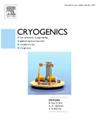Taconis oscillations are thermally induced spontaneous excitations of acoustic modes in tubes subjected to large temperature gradients. Cryogenic systems that experience these excitations suffer from increased heat leak and vibrations. This heat leak may also increase boil-off in long-term storage vessels for liquid hydrogen. In this study, U-shaped closed-end tubes with a cold mid-section are experimentally investigated to quantify the oscillation characteristics for hydrogen- and helium-filled systems at various mean pressures, including supercritical hydrogen states. Experimental measurements of the temperature distribution along the tube and acoustic pressure amplitudes and frequencies are taken in constant- and variable-diameter configurations near the onset of oscillations. Thirty different conditions are recorded with mean pressures ranging from 126 kPa to 1127 kPa for helium and 161 kPa to 1816 kPa for hydrogen. A low-amplitude thermoacoustic model is applied to predict the cold temperature and frequency corresponding to the onset of Taconis oscillations. The findings of this study indicate that Taconis oscillations in systems with hydrogen occur at smaller temperature differences than in more traditional helium systems by approximately 10 K. Hydrogen in the constant-diameter configuration excited when cryogenic temperatures reached 35–40 K, whereas helium excited when cryogenic temperatures reached 20–30 K. Special tubing networks, such as wider segments in the warm portion, can drastically elevate the excitation cold temperature resulting in onset temperatures between 50–60 K for both fluids. Taconis oscillations are also found to exist in conditions when liquid hydrogen starts forming in the cold zone of the system, as well as in supercritical states. The presented measurements are useful for designing cryogenic hydrogen storage systems to control these oscillations.


